
Written by Richard Covington
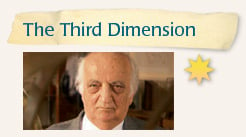 |
 |
| Thorne Anderson |
 |
| ART ARCHIVE /UNIVERSITY LIBRARY ISTANBUL /DAGLI ORTI |
| An astronomer calculates the position of a star with an armillary
sphere and a quadrant in this illustration from a 16th-century Ottoman
manuscript. Below: The 10th-century astronomer Abu Sa’id al-Sizji held the
contemporary view that the Earth was the center of the universe, but he
modeled the solar system on the concept that the Earth rotated on its
axis—as shown in this display at the Institute for the History of
Arab–Islamic Science in Frankfurt. |
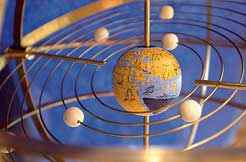 |
| THORNE ANDERSON |
 ou have to hand it to Ahmed Djebbar: The science historian
certainly knows how to draw a crowd. As we circulate among the
astrolabes, maps and hydraulic models of an eye-opening Paris
exhibition on medieval Arabic science, curious museum-goers gather
around us.
ou have to hand it to Ahmed Djebbar: The science historian
certainly knows how to draw a crowd. As we circulate among the
astrolabes, maps and hydraulic models of an eye-opening Paris
exhibition on medieval Arabic science, curious museum-goers gather
around us.
“Did you know that the Egyptian doctor Ibn al-Nafis recognized
that
the lungs purify blood in the 13th century, nearly 350 years before the
Europeans?” he asks, standing in front of an anatomical drawing of the
human body. “Or that the Arabs treated the mentally ill with music
therapy as early as the ninth century?”
Examining a case of rare manuscripts, the dapper Lille
University
professor launches into a mini-lecture before the rapt group. The
13th-century Persian astronomer Nasir al-Din al-Tusi, the author of one
of the yellowing Arabic-language texts, upended the geocentric Greek
view of the universe, Djebbar explains, by declaring Ptolemy’s model of
planetary motion flawed and creating his own more accurate, but still
Earth-centered, version. Three centuries later, the Polish astronomer Nicholas Copernicus borrowed al-Tusi’s
model to make the shocking proposition that the Earth revolves around the
sun. “Al-Tusi made his observations without ctelescopes or even glasses,”
says Djebbar, removing his own spectacles and waving them theatrically
in the air. “Even though the Arabs possessed the knowledge to make
lenses, they probably thought it was an idiotic idea. God made us like
this; why hang something on our noses to see better?” he jokes, placing
his glasses back on his nose with a flourish. His audience erupts into
laughter as Djebbar, who was curator of “The Golden Age of Arabic
Sciences”—the Paris exhibition, which ran from October 2005 through
March 2006 at the Arab World Institute—tries to quiet them down.
For most westerners, and indeed for many Arabs, the
spectacular
achievements of Arabic-language science from the eighth through the
16th centuries come as a startling discovery, as if an unknown
continent had suddenly appeared on the horizon. In mathematics,
astronomy, medicine, optics, cartography, evolutionary theory, physics
and chemistry, medieval Arab and Muslim scientists, scholars, doctors
and mapmakers were centuries ahead of Europe. Centers for scientific
research and experimentation emerged across Muslim lands—in Baghdad,
Cairo, Damascus, Samarkand, Shiraz, Bukhara, Isfahan, Toledo,
Córdoba,
Granada and Istanbul.
Generations of science historians once rejected Islamic
accomplishments. One critic, the French physicist Pierre Duhem, even
accused Muslims of trying to destroy classical science in his 1914–1916
historic survey Le
Système du Monde (The System of the World). Others
asserted that the Arabic language itself was not suited for science,
contends Roshdi Rashed, the dean of Islamic science in France.
“Otherwise well-respected scholars like Ernest Renan and Paul Tannery
excluded even the possibility of an Arabic contribution to
science,” says Rashed, a former fellow at the Institute for Advanced
Studies in Princeton, professor emeritus at the University of Paris and
editor of the three-volume Encyclopedia
of the History of Arabic
Science.
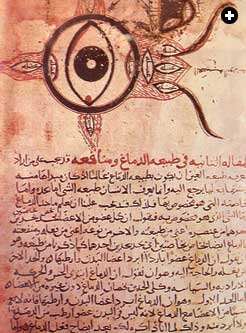 |
| The earliest known medical description of the eye, from
a ninth-century work by Hunayn ibn Ishaq, is shown in this copy of a
12th-century manuscript at the Institute. Below: Kamal al-Din al-Farisi’s 13th-century
demonstration of
the separation of the visible spectrum of light by double refraction,
reproduced in this display at the Institute for the History of
Arab–Islamic Science in Frankfurt, helped advance the science of
optics. |
 |
| THORNE ANDERSON (2) |
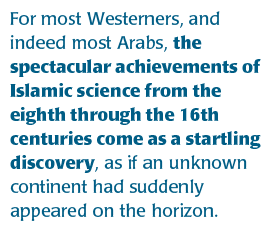
Although an alternative spectrum of science historians,
beginning with the 19th-century European Orientalists Jean-Jacques
Sédillot and Eilhard Wiedemann and including the
20th-century Harvard
professor George Sarton, staunchly promoted the pivotal Arab/Muslim role in science, the general public has remained largely unaware of
Arab discoveries. The 1300-year period between the Greek golden age of
science (from the fifth century BC to the second century of our era) and the 15th-century Italian Renaissance was perceived
as a scientific desert. If Arab scholars were acknowledged at all outside academia, they were seen merely as useful messengers, conduits who
preserved the classical Greek knowledge of Euclid, Aristotle,
Hippocrates, Galen, Ptolemy, Archimedes and others through Arabic texts.
True enough, much of ancient science came back to Europe via
Arabic translations, which were subsequently translated into Latin and
other languages. (See “Lines of Transmission”). Some key texts, like Ptolemy’s Planisphere, Galen’s
commentary on Hippocrates’ treatise Airs, Waters, Places and the final
chapters of the third-century BC mathematician Apollonius’ book on
conic sections exist only thanks to the Arabic translations, since the
original Greek manuscripts have all disappeared.
But according to astrophysicist Jean Audouze, director of the
French National Center for Scientific Research in Paris, the Arabs were
not simply transmitters of Greek concepts; they were creators in their
own right. Like Djebbar and Rashed, Audouze is one of a small number of dedicated scholars —fewer than 150 in France, Germany and Britain, but also scattered
through the US, Arab countries, Asia and Latin America—who are
struggling to give Arabic science the long overdue respect it deserves.
 |
| INTERFOTO PRESSEBILDAGENTUR / ALAMY |
| Arab astronomers study the heavens in this print from a
commentary
on Cicero’s Somnium Scipionis, whose central character ranges through
the celestial spheres that surround the Earth, and carry the planets
and the stars. Below: The Canon of Medicine by Ibn Sina (known as Avicenna in the
West) was first translated from Arabic into Latin in the 12th century and into Hebrew in 1279. It served as the chief guide to medical science in Europe and
was used in medical schools there until the mid-17th century. |
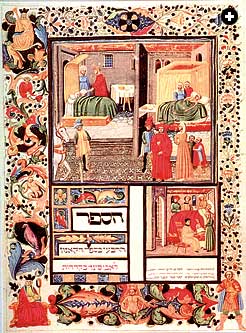 |
| BIBLIOTECA UNIVERSITARIA DI BOLOGNA / NATIONAL LIBRARY OF MEDICINE |
“One of the more drastic consequences of the dismissal of the
vast Islamic contribution is that you cannot understand classical science without it,” argues Rashed. “If you
reduce the distance between Greek science and 17th century science, you are going to say, for example,
that Apollonius first conceived algebraic geometry. But he has nothing
of the kind in his writings. ”
“Either you push Apollonius to invent ideas he did not have or
you
pull back 17th-century scholars closer to Greek levels of
understanding. This results in very serious errors of perspective. But
if you take into account Arabic science, you are better able to
understand what is truly new in the 17th-century outlook and the steps
that led from Greek classical science.”

Tunisian geologist Mustafa El-Tayeb, director of science
policy and
sustainable development for the United Nations Education, Scientific
and Cultural Organization in Paris, is another impassioned advocate for
Islamic science. He believes that reclaiming a proper place for medieval Arab achievements is vital for encouraging
future generations of Arab and Muslim researchers.
“When I hear reactionaries preaching to young Muslims that
science is not good for Islam, I want these students to realize that it’s a crucial part of their heritage and not something
to be rejected, or seen as alien,” says El-Tayeb. “As it is, the
history of Islamic science is barely taught at all in universities
across the Middle East.”
In fact, the discipline is everywhere in a deepening crisis,
warns
George Saliba, professor of Arabic and Islamic science at Columbia
University. “The most urgent need now for the study of Islamic science
is to train people who can edit and publish the hundreds of scientific
texts that are still lingering in world libraries with almost no
one aware of their existence, let alone their contents,” he says. “But
despite this need, Islamic science historians are becoming an endangered species.” To make his point, Saliba cites
the 200 to 300 Muslim treatises on planetary theories that he“s tracked
down. Only two have been translated into European languages—one into
Latin centuries ago and the other, in modern times, into English.
 |
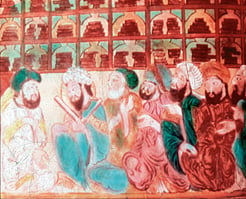 |
| THE PRINT COLLETOR / ALAMY |
| From Baghdad’s Bayt al-Hikmah (“House of
Wisdom”), the Islamic world’s premier science
academy for some 400 years until the city’s destruction by
the Mongols in 1258, came translations of Greek mathematical and scientific papers, breakthroughs in geometry and discoveries in fields
from hydrology to medicine. |
 thousand years before English emerged as the international language
of science in the latter half of the 20th century, the Arabic language unified scholars across the
Muslim world, generating a lively market of ideas from Samarkand to
Córdoba. “A book published in Central Asia could
be read in southern Spain less than a year later,” explains
Roshdi Rashed, an eminent Egyptian-born historian of science, in his
office near Paris. “Islamic learning was not like Greek
science, which was limited principally to the eastern Mediterranean,
but was spread across most of the known world.” thousand years before English emerged as the international language
of science in the latter half of the 20th century, the Arabic language unified scholars across the
Muslim world, generating a lively market of ideas from Samarkand to
Córdoba. “A book published in Central Asia could
be read in southern Spain less than a year later,” explains
Roshdi Rashed, an eminent Egyptian-born historian of science, in his
office near Paris. “Islamic learning was not like Greek
science, which was limited principally to the eastern Mediterranean,
but was spread across most of the known world.”
One celebrated example is the Kitab al-Istikmal, a treatise on geometry
by Yusuf al-Mu’taman, the 11th-century king of Sarakusta
(today’s Zaragosa in northern Spain). The Jewish philosopher
Maimonides brought it from Córdoba to Cairo and copies were
soon circulating in Baghdad. The work was eventually republished in the
13th century in Central Asia.
Among the babel of scientists and scholars who crisscrossed the
polyglot Muslim empire, the common language was Arabic.
“Besides Maimonides, you have the great mathematician and physicist Alhazen (Ibn al-Haitham)
moving from Basra to Cairo,” says Rashed, “and the
astronomer Nasir al-Din al-Tusi journeying every year from Khorasan in northern Iran
through Iraq and on to Aleppo to teach.” Even if scholars
spoke Persian or another language at home, they wrote their papers in
Arabic so that their colleagues in Baghdad, Toledo and elsewhere could
understand them, he adds. Omar Khayyam may have penned his quatrains in
Persian, but he explicated his mathematical concepts in Arabic.
Correspondence among scientists—typically carried by cara- van messenger or carrier pigeon—was nearly as far-reaching in
the 11th and 12th centuries as it was in the 17th, Rashed maintains.
But despite its ultimate ascendancy, scholarly Arabic had a slow start.
“Before the advent of science, Arabic was the language of
poetry; it soon became the language of the new religion of Islam, but
paradoxically, it did not become the language of power right away,” explains
French science historian Ahmed Djebbar. Although the Umayyad caliph
‘Abd al-Malik decreed at the beginning of the eighth century
that government institutions, schools, courts and communications
conduct their business in Arabic, it took another 50 to 100 years
before the translation of scientific texts from Greek, Syriac, Persian
and Indian languages into Arabic got under way in earnest, with some
100 translators
at work over the course of the ninth and 10th centuries, according to
the 10th-century bibliographer Ibn al-Nadim of Baghdad.
Baghdad’s Bayt al-Hikmah (“House of
Wisdom”) became a vibrant center of translation. Works like
Ptolemy’s Almagest and Dioscorides’ De Materia
Medica were translated numerous times as scholars perfected Arabic
terminology. The Greek word parabola was initially Arabicized
phonetically
as barabula, then subsequently refined to qat za’id, which
literally means “thick section.” Diabetes was first
rendered as diyabita then transformed to da as-sukkar (“sugar
sickness”).
Over time, Arabic scientific terms and star names were adopted into
other languages, a list that includes alkali, alcohol, algebra,
algorithm, alembic, alchemy, azimuth, elixir, nadir, zenith, Betelgeuse, Aldebaran, Rigel and Mizar.
After some seven centuries in which Arabic dominated scientific
discourse, it began to be eclipsed in the 15th century by Turkish as
Ottoman rule expanded. Ghiyath al-Kashi’s 1427 mathematical
treatise Risala al-Muhitiya (Treatise on the Circumference), in which
he calculated the value of pi to 17 decimal places, was one of the last
significant scientific texts in Arabic. By the time Taqi al-Din, the
director of the Istanbul observatory, wrote his books in Arabic on
light and marvelous machines in the second half of the 16th century,
Latin had largely supplanted Arabic as the universal language of
science. Unlike Arabic, however, which was understood by all classes
and gave ordinary Muslims access to scholarly knowledge, Latin was used
principally by academics and clergy, fencing science in as the preserve
of an educated elite.
|
Yet the duty to promote the Arab intellectual legacy has never
been
greater, argues Rashed, underscoring the philosophical alliance between
science, which strives for unity in the natural world, and religion,
which seeks a similar balance in the realm of the spirit. “Muslim science demonstrates that there has always been
a profoundly rational base to Islamic civilization,” he explains.
Drawing principally from Greek texts, but also Persian and
Indian
sources, medieval Islamic scientists made a staggering number of
breakthroughs. The brilliant ninth-century Baghdad mathematician
Muhammad ibn Musa al-Khwarizmi invented algebra, initially to resolve
property disputes (even though countless generations of high school
students wish he hadn’t bothered). He also solved linear and quadratic
equations using algorithms, the basis of computer programming; the term
itself is derived from his surname, testimony to al-Khwarizmi’s
enduring gift to mathematics.
 |
| BETTMANN / CORBIS |
| The Persian polymath-physician Avicenna appeared with his
Greek
forebears Galen and Hippocrates in this woodcut from an early 15th-century Latin medical book. Below: Avicenna remains a hero today. His portrait decks a wall in Bukhara, Uzbekistan. |
 |
| CHARLES & JOSETTE LENARS /
CORBIS |

Reversing the false Greek notion that light is emitted from
the eye,
the 11th-century physicist Alhasan ibn al-Haitham, known in the West by his Latinized first name as Alhazen, correctly asserted in Cairo that light rays travel in the
opposite direction, reflecting off the surface of objects to enter the
eye. Devising the first rudimentary pinhole camera, or camera obscura, Alhazen demonstrated that light emanates from an object in
straight lines, establishing the principle of linear perspective
essential to the art of Leonardo da Vinci and other Renaissance
masters. (Alas, the Basra-born scientist did not invent film for his
primitive camera; civilization would wait until the 19th century for
the first photograph.) By putting his concepts to various tests, using
the camera obscura and other tools, Alhazen also introduced the
experimental method of proof, insisting that theories had to be
verified in practice, a key element to modern science that was missing
from the less empirical Greek tradition.
“Arab science succeeded as much in pragmatic applications as
it did
in theoretical concepts,” Audouze maintains. “Islamic scholars
distinguished themselves from their Greek predecessors, who were more
inventive in ideas than in practical matters.” Arab scholars also
introduced the practice of peer review and citations to confirm their
source material.
Although the Babylonians, Indians and Egyptians had
astronomical
observatories, those founded under Islamic rulers in Maragha (in
present-day Iran), Samarkand and Istanbul were far more sophisticated,
equipped with an impressive array of astrolabes, sundials, sextants,
celestial globes and armillary spheres to track the movements of the planets and constellations.
Skilled at determining the precise location of Makkah from
anywhere
in the Muslim empire, Islamic astronomers were unsurpassed in their
calculations and predictions. Many mosques engaged a full-time
astronomer, called a muqqawit,
to determine the hours of prayer and consult lunar calendars to fix the dates for Ramadan and other religious events.
Persian astronomer Muhammad ibn Ahmad al-Biruni (973–1048), a
protean intellectual figure who wrote in Persian, Arabic, Greek, Hebrew
and Sanskrit, and lived in Kath (in present-day Uzbekistan),
corresponded with Abu al-Wafa, another astronomer 2000 kilometers (1242 mi) west in Baghdad, to coordinate the simultaneous
observation of a lunar eclipse. On May 24, 997, according to
al-Biruni’s book Al-athar al-baqiyah an
al-qurun al-khaliyah (Vestiges of Bygone Days, usually shortened to The
Chronology), they got their eclipse, measuring
its duration and the moon’s angle in the sky to calculate the longitude
of Kath with unprecedented exactitude.
 |
| ART ARCHIVE /UNIVERSITY LIBRARY ISTANBUL /DAGLI ORTI |
| Arab physicians added hundreds of medicines to those recorded
by the Greeks. In this Ottoman manuscript, two doctors give instructions on the
preparation of prescriptions. |
Arab astronomers and cartographers strove for—and frequently
achieved— uncanny accuracy. To ascertain the distance separating
degrees of latitude for a projected global map, the ninth-century
Baghdad caliph al-Ma’mun dispatched 70 scientists into the Syrian
desert. Using astrolabes, measuring rods and stretched lengths of cord,
the teams walked until they observed a change of one degree in the elevation of the polestar, the equivalent to a degree of
latitude. Reckoning the distance traveled at 562 2/3 Arab miles (64.5 statute miles or 103.8 km), they
computed the
Earth’s circumference, which is 360 degrees, as 23,220
statute miles, or around 37,380 kilometers, a respectable error only
about seven percent less than the true figure of 24,800 miles (40,000
km). (However, around 200 BC the Alexandrian geographer Eratosthenes
handily beat their estimate, calculating the Earth’s circumference at
39,690 km.)
Arabic/Muslim achievements in medicine were also impressive.
The ninth-century Persian doctor Muhammad ibn Zakariya al-Razi, known in Latin as Rhazes, penned the first
treatise on smallpox in his Kitab
al-tajarib (Book of Experience), which probed some 900 cases of various maladies. Another Persian doctor, Abu Ali ibn
Sina, or Avicenna (980–1037), compiled Qanun
fi ’l-tib (Canon of Medicine), a
five-volume compendium of Greek and Islamic healing that became one of
the principal textbooks in European universities centuries later.
Abu al-Qasim al-Zahrawi (Abulcasis in Latin), a 10th-century surgeon in Córdoba, composed Al-Tasrif, a 30-chapter medical encyclopedia describing dozens of operations,
complete with graphic illustrations of surgical instruments, including
scalpels, cauterizing tools, feeding tubes and cupping glasses. (A
15th-century Turkish edition added instructively terrifying depictions
of doctors treating patients.) Some 300 years after al-Zahrawi, another
Andalusian doctor, Ibn al-Baitar, published Al-jami li mufradat al-adwiyya wa
l-aghdhiyya (Book of Simple Medications and
Alimentations), adding more than 400 medicines and
curative plants to
the 1,000 catalogued by the first-century doctor Dioscorides and other
Greek botanists.

Arab scholars even theorized about evolution, arriving at
conclusions that anticipated Darwin. In 1377, nearly half a millennium before the 1859 publication of On the
Origin of Species, the Tunisian-born
historiographer Ibn Khaldun, renowned as one of the founders of sociology, asserted in Al-Muqaddimah
(Prolegomena), “The animal kingdom was developed, its
species multiplied, and in the gradual process of Creation, it ended in man & arising from the world of the
monkeys.”
The period from the ninth through the 16th centuries was also
a
golden age for hydraulic technology, with Muslim engineers devising
underground canals, dams, waterwheels and water-lifting machines to
modernize agriculture and provide fresh water to rapidly growing cities
from Córdoba to Samarkand. Intricate water clocks, pumps and
piston-driven machines were the forerunners of mechanisms that would
not appear in Europe until the Italian Renaissance and later with the
development of steam and internal-combustion engines in the 18th and
19th centuries.
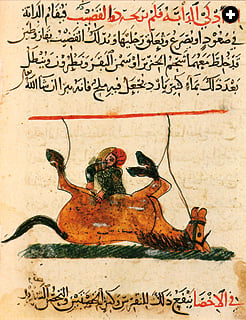 |
| ART ARCHIVE /UNIVERSITY LIBRARY ISTANBUL /DAGLI ORTI |
| Arab physicians added hundreds of medicines to those recorded
by the Greeks. In this Ottoman manuscript, two doctors give instructions on the
preparation of prescriptions. |
The importance of all branches of learning, including science,
is
emphasized in the Qur’an itself, which reads, in Chapter 58, Verse 11,
“God will raise up in rank those of you who have been given knowledge.” The value placed on scholarship by Muslims at large is underscored by two
sayings popularly linked to the Prophet Muhammad: “Search for learning
even if it be in China,” and “The quest for learning is a duty for
every Muslim.” Although these sayings cannot be traced to authentic hadiths (traditions) of the Prophet, they reflect the general feeling
of esteem in which the Muslim community holds learning, based on the
Qur’an’s emphasis on the importance of knowledge and reason, and
respect for learned persons.
To Djebbar, early theological debates over the meaning of the
words
in the Qur’an, interpretations of hadith and etymological arguments on
the Arabic language itself all nurtured the questioning spirit of
rationalism necessary for scientific development. “These [religious and
linguistic] critiques are the true departure point for the Arabic scientific tradition,” he asserts in his 2001 book, Une histoire de la
science arabe (A History of Arabic Science).
Although Umayyad princes filled libraries in Damascus with
Greek
scientific texts from Spain, beginning in the early eighth century, and
commissioned Arabic translations, the main push for scientific inquiry
arose in Baghdad around the time of the city’s founding in 762.
Beginning with the first Abbasid caliph, al-Mansur, the
victorious
dynasty promoted science for ideological and political reasons. “The
new rulers needed capable astronomers and geographers to measure the
recently conquered empire under their control and to demonstrate to
their subjects that Abbasid power was a force for good,” Djebbar
explains. As rural populations migrated to the cities, creating a
highly diverse, socially volatile mix of peoples, the demand for
competent doctors, engineers and scientists exploded. Baghdad had a
population of more than 800,000 inhabitants by the 10th century, and
was, after Constantinople, the largest city on Earth.

At the end of the eighth century, Harun al-Rashid, the
grandson of
al-Mansur and the caliph whose court inspired The Thousand and One
Nights, erected Baghdad’s first paper mill, the second in
the empire.
(The first mill had been constructed in Samarkand by Chinese engineers captured in the Battle of Talas in Central Asia around 750, according to Djebbar. The Chinese, who had been making paper since at least the second century BC, had kept the process a jealously guarded
secret.) Shortly after the Baghdad plant opened, paper mills cropped up
in virtually all the major Muslim cities. By the end of the 12th century,
the Moroccan capital Fez sustained some 400 paper-making workshops.
The introduction of paper into the Middle East was a key
technological breakthrough and a critical innovation for the spread of
science. Paper gradually supplanted parchment and papyrus, making
publication of manuscripts far cheaper and providing access to ideas
for a much broader range of the educated public. Feather-light but
sturdy paper was developed for use in correspondence by carrier pigeon.
Since al-Biruni’s Chronology mentions an exchange of letters with Abu
al-Wafa to measure an eclipse, Djebbar suggests that the two astronomers used
carrier pigeon “air mail” to speed up their 2000-kilometer
correspondence between Kath and Baghdad.
 |
| BIBLIOTHÈQUE NATIONALE / ARCHIVES CHARMET /
BRIDGEMAN ART LIBRARY |
| The 10th-century Andalusian surgeon Abu al-Qasim Khalaf
ibn
al-Abbas al-Zahrawi (known as Abulcasis in the West) wrote many medical
books, including The Properties of Various Products. This page discusses the use and preparation of absinthe. Below: Two types of thyme are depicted on these pages of De Materia Medica, a guide to remedies
by the Greek physician Dioscorides that was translated into Arabic in
Baghdad in 1240. |
 |
| ART ARCHIVE / BODLEIAN LIBRARY |
Around the same time that Harun al-Rashid ushered in the paper
mill,
he also founded Baghdad’s first hospital and a separate scientific
academy known as Bayt al-Hikmah (“House of Wisdom”). Initially little
more than the caliph’s private library, the House of Wisdom became a
full-blown research and translation center and astronomical observatory
under al-Rashid’s son, Caliph al-Ma’mun, who ruled from 813 to 833. It
was here that the versatile al-Khwarizmi developed algebra and, turning
his hand to cartography, drafted an elaborate map tracing the meanders
of the Nile River.
According to Ibn al-Nadim, a local 10th-century bibliographer,
al-Ma’mun had a prophetic dream of the white-bearded Aristotle seated
on a throne in which the Greek philosopher advised the caliph on the
path to wisdom through reason, law and faith. Al-Ma’mun took this
vision as a sign to amass knowledge and shortly afterward sent a cohort
of academics to Byzantium to bring back reams of scientific and philosophical texts to be translated into Arabic. Gradually, scholars acquired manuscripts
from state archives and private collections in Alexandria, Damascus, Antioch, Harran and other cities. Although
most of the books were in the original Greek, many volumes had already
been translated between the fifth and seventh centuries into Syriac,
the western Aramaic tongue used in ancient Syria. This massively
ambitious initiative to translate Greek, Syriac, Persian and Indian
treatises into Arabic lasted more than 200 years, from the middle of
the 700’s until the end of the 10th century, according to Djebbar. (See
“The Language”, above).
Al-Ma’mun’s patronage set an example, prompting princes,
merchants,
doctors and well-to-do scholars to finance research with charitable
endowments, known as awqaf (waqf in
the singular). “Scientists were
always close to the courts; there was no such thing as independent science,” explains Rashed. “One had to
eat and for that the scholars needed a patron, either the caliph, a wealthy merchant or a nobleman.”
The support of powerful benefactors became a vital element for
the
development of science across the Muslim empire. In Córdoba,
the
10th-century caliph al-Hakam II sponsored extensive scholarly missions
to scour manuscript collections in the eastern capitals to stock a
library that soon rivaled the best in the world. In the early 11th
century, the Fatimid ruler al-Hakim invited the renowned mathematician
and physicist Alhazen to teach in his court, greeting him in person at
the gates of Cairo, an extraordinary honor that gave a tremendous boost
to the prestige of science in Egypt. That honeymoon ended
abruptly, however, when Alhazen failed to realize the caliph’s scheme
to regulate Nile flooding. Feigning madness to avoid execution, the
scholar was placed under house arrest, taking advantage of the solitude
to churn out a flood of treatises, biding his time until al-Hakim’s
death in 1021.
Generally, scientists worked without religious constraints,
Djebbar
maintains, with Nestorian Christians, Jews and Muslims collaborating in
relative harmony. The sort of persecution that inflamed the Spanish
Inquisition in the 15th century and later fired the 1633 heresy trial
of Galileo in Rome did not occur in Islamic countries at the time, he
says.
“It was not because Muslims were nicer people than
Christians,” the
professor explains. “It was a matter of timing. In Christian countries,
there was a scientific renaissance at a period when religion had
already locked the doors of experimentation and speculation. In Arab
countries, science arose shortly after Islam was established, creating its own secular space without reference to religion.”
There were, however, isolated instances of repression. Shortly
after al-Hakam II’s death in Córdoba in 976, the prime minister Abu Amir al-Kahtani, who assumed power as regent for the underage prince Hisham,
burned many of the manuscripts the caliph had acquired at such great
cost, claiming that the teachings of the Greeks, particularly in
astronomy and philosophy, contradicted the Qur’an. Only works of
medicine and arithmetic were spared. Some 150 years later, in the 12th
century, the Baghdad theologian and mystic Muhammad al-Ghazali branded
theoretical mathematics and physics as dangerous, claiming that they
bred a rationalistic philosophy that led to atheism, according to
Djebbar.
Astrology also provoked a heated polemical debate that lasted
for
centuries. “Critics argued that astrology lied to people by claiming to
predict the future when only God can see the future,” says Djebbar,
“but no Muslim astrologer—and there were many at the various courts—was
ever put to death because of his predictions.”
Although the first astronomical tables for calculating the
positions
of stars and planets arrived in Baghdad from Persia and India in the
eighth century, the chief reference for Islamic astronomy was Ptolemy’s Almagest, or The Great Book, initially translated into Arabic by al-Hajjaj around
828. Contrary to a common misperception, the second-century scholar
from Alexandria did not believe the Earth was flat. Like his Arab
successors, however, he was convinced that the sun, moon and planets
revolved in celestial spheres around the Earth. In an attempt to match
this geocentric theory with the actual movement of heavenly bodies,
Ptolemy posited an eccentric model that depended on off-center orbits
that were “physically impossible,” according to Saliba of Columbia
University. Struggling to reconcile the Greek universe with their own
observations led a number of Islamic astronomers to challenge Ptolemy’s
faulty concepts of celestial motion.
 |
 ong before Dan Brown’s Da Vinci Code popularized the Fibonacci sequence as an early clue to his murder mystery, the 13th-century Italian
mathematician who gave his name to that number series was learning the
principles of advanced arithmetic from Arab teachers in Bejaia, in
present-day Algeria. In the Fibonacci sequence, every number after 0
and 1 is the sum of the previous two numbers, ong before Dan Brown’s Da Vinci Code popularized the Fibonacci sequence as an early clue to his murder mystery, the 13th-century Italian
mathematician who gave his name to that number series was learning the
principles of advanced arithmetic from Arab teachers in Bejaia, in
present-day Algeria. In the Fibonacci sequence, every number after 0
and 1 is the sum of the previous two numbers,
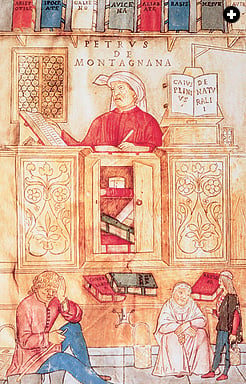 |
| BIBLIOTHÈQUE DE LA FACULTÉ DE MÉDECINE / ARCHIVES CHARMET / BRIDGEMAN ART LIBRARY |
| This woodcut from a book about the nervous system, published in Venice in 1495, shows shelved reference volumes by Muslim physicians Avicenna, Rhazes and Ibn Rushd, alongside works by Aristotle and Hippocrates.
|
so that the sequence
runs: 0, 1, 1, 2, 3, 5, 8, 13, 21, 34, 55, 89, 144, 233, 377, 610, 987,
1597, 2584, 4181, 6765, 10,946 and so on. The series appears in nature in many forms, including the spiral
arrangements of sunflower seeds, pineapple fruitlets and pinecone
scales; it appears in geometry, where, starting with the number 5,
every other Fibonacci number is the length of the hypotenuse of a Pythagorean right triangle with integral sides; it recurs in
mathematics, where the ratio between successive Fibonacci numbers
approaches the classical “golden ratio” of
1:1.618033….
Like the Polish astronomer Copernicus and the Spanish
physician Michael Servetus in the 16th century, Fibonacci, who was one
of the founders of western mathematics, constructed a substantial
portion of his pioneering scientific research on the foundations laid
by his Arabic-speaking predecessors. Using Latin translations of
Muhammad ibn Musa al-Khwarizmi’s treatises on algebra and
algorithms, Fibonacci, also known as Leonard of Pisa, wrote the Liber abaci, the
first widely available book on Arabic numerals and arithmetical
problems, expanding Indian-based concepts that had arrived in Spain
starting in the 10th century.
On an expedition to Catalonia around 967 in search of unknown
manuscripts, Gerbert, a Benedictine monk from Aurillac in Provence who
later became Pope Sylvester II, came across Latin texts explaining
Arabic numerals. He later taught about them, in Rheims and Rome, using
a rudimentary abacus. From these modest beginnings, ancient Greek
knowledge preserved in Arabic texts, as well as original Muslim
science, was translated principally into Latin, Hebrew and Castilian
Spanish to blossom gradually across Europe. In the courts of Toledo,
Palermo and London, and the universities of Salerno, Padua, Paris and
Oxford, a network of intellectual cross-pollination arose that spanned
more than half a millennium, ushering in a European scientific
renaissance.
Translators such as Gerard of Cremona from Italy, Adelard of
Bath from England, Constantine the African, who brought an entire
library of Muslim medicine to Salerno, and Michael Scot, a Scotsman who
studied in Spain and Sicily, crisscrossed Europe. These itinerant
scholars disseminated critical Arab revisions of Greek learning and
popularized the revolutionary innovations made by generations of
Islamic astronomers, physicians, mathematicians and physicists. Roger
Bacon, the 13th-century proponent of the experimental method,
astronomers Tycho Brahe in the 16th century and Galileo in the 17th,
English physician William Harvey, who formulated his theory of blood
circulation on Arab models in the 17th century, and many others owe a
direct debt to Muslim knowledge brought to the West in this period.
Occasionally, there was a distinctly personal link between
East and West. Journeying to Aleppo and elsewhere around the Middle
East, the 17th-century Dutch Orientalist Jacobus Golius, who spoke and
read Arabic, brought back the tracts of Alhazen. Since his son was
secretary to Descartes in the Dutch city of Leiden, Golius excitedly
showed his acquisitions to the exiled French mathematician, who
incorporated the Muslim physicist’s findings on optics and
geometry into his own writings, according to French science historian
Roshdi Rashed.
The transmission of Islamic science to Europe was not a fixed
event like the delivery of a package whose contents launched the
Renaissance. It was an ongoing, fluid exchange over time, a transfer
that traveled in both directions, although it flowed mostly from East
to West. Once Christian armies began to retake Spain in the 11th
century and Crusaders returned from the Middle East over the course of
the 12th and 13th centuries, western scholars began a dogged search for
Arabic texts. Some key Arab and Persian documents, such as
Alhazen’s Kitab
al-Manazir (Book on Optics) and al-Khwarizmi’s Book on Indian Calculation, lost in their Arabic editions, have survived thanks only to Latin
translations.
“The translators were very important, but there was
also a great deal of direct contact among the scientists themselves,” points
out Rashed. “This explains why you find the same information
in Arabic and Latin texts even though they are not exact translations; there was
also verbal transmission of the knowledge.”
The Castilian city of Toledo, which was reconquered by King
Alfonso vi in 1085 after nearly four centuries of Arab rule, became a
magnet for scholars intent on harvesting Arab and Greek science.
According to science historian Ahmed Djebbar of the University of Lille, more than 100 major scientific and
philosophical essays were translated in Toledo from Arabic into Latin
and Hebrew between 1116 and 1187. In a typical example illustrating the
cosmopolitan nature of this mountaintop city, the English philosopher
Daniel of Morley recounts meeting the Italian linguist Gerard of
Cremona near the banks of the Tagus River. The two foreigners were
awestruck by the vestiges of several monumental water clocks built by
Ibrahim ibn Yahya al-Zarqali (Azarchel in Latin) shortly before the
city fell to Alfonso.
By far the most prolific translator of the era, Gerard had
left Italy chiefly in quest of Ptolemy’s Almagest, which
existed only in Arabic and Syriac, a pre-Islamic language of ancient
Syria. Uncovering an Arabic transcription in Toledo, he stayed there 30 years, making Latin translations of
Ptolemy, Ibn Sina’s Canon, astronomical coordinates by al-Zarqali that became known as the “Toledan
tables,” and al-Zahrawi’s manual on surgery,
featuring a tonsillectomy technique as gruesome as it was efficacious.
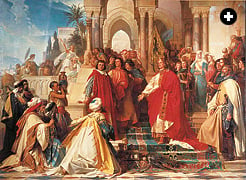 |
|
stiftung maximilianeum, munich / neue pinakothek |
| The Holy Roman Emperor Frederick II, pictured in his court in Palermo,
Sicily, continued the fruitful contacts with Muslim scholars initiated
by his father, Roger II, even during time of war. He furthered learning
by financing translations of Arabic works into Latin. |
Around the same time, Adelard of Bath, who had spent seven
years traveling as far as Antioch seeking learning based on
“reason rather than authority,” as he wrote in Quaestiones Naturales, returned to the court of English king Henry i. There he introduced
Muslim research on trigonometry, botany, falconry and other subjects.
Soaking up Muslim mathematics and astronomy in Córdoba and
Toledo, his compatriot Daniel of Morley later lectured his Oxford
students that they should “not despise the simple and clear
opinions of the Arabs, but should note that Latin philosophers make
heavy weather of these subjects quite unnecessarily.”
Although Daniel of Morley’s books from Spain were destroyed
in English religious wars, Oxford’s Bodleian Library later
built up one of the most important collections of medieval Arabic
manuscripts and 12th- and 13th-century Latin texts translated from Arabic sources.
Landing in southern Italy around 1060 from Qayrawan, in
today’s Tunisia, Constantine the African became a Benedictine
monk at the abbey of Montecassino, 130 kilometers (80 miles) south of
Rome. He transcribed numerous Arabic books, including Hunayn ibn
Ishaq’s versions of discourses by Galen and Aristotle, Ibn
Ishaq’s manual on ophthalmology and the physicians’ encyclopedia of Ali ibn Abbas al-Majusi. Rapidly adopted by doctors at
Salerno’s medical school, Constantine’s
translations eventually filtered into France, England and Germany.
Even the Crusades failed to slow the pace of intellectual
discourse—quite the contrary, argues Roshdi Rashed.
“The Crusaders brought back a great deal of science,
medicine, foods and so forth from the Middle East,” he
explains. In the first half of the 13th century, in fact, the
Arabic-speaking Holy Roman Emperor Frederick II maintained a thriving
correspondence with Muslim philosophers and scientists from his court
in Palermo, Sicily, and even during his occupation of Jerusalem.
“When you consider the two sides were in the middle of
fighting one another, this is fairly astonishing,” marvels
Rashed.
Frederick enthusiastically encouraged Muslim scientists, an
enlightened policy of Arab–Christian cooperation begun by his
grandfather, Roger II, who had sponsored the geographer Muhammad al-Idrisi.
(See “The Third Dimension”.) In addition, Frederick financed translations of Arabic works,
enlisting the services of Michael Scot, the astronomer-alchemist-wizard
who later earned a place in Dante’s Inferno. Scot had
achieved renown in Toledo for transcribing Nur al-Din ibn Ishaq
al-Bitruji’s astronomical treatises on planetary motion and Averroes’ commentaries on Aristotle into Latin, according to French science
historian Danielle Jacquart. Both texts represented heretical
challenges to Catholic doctrine, and hiring such a subversive character
no doubt contributed to the emperor’s ongoing problems with
the church, which ultimately excommunicated Frederick II not once, but
twice.
Around 1277, Toledo again became the focus of Muslim science,
as King Alfonso X commissioned the first renditions of Arabic texts
into Castilian Spanish instead of Latin. Apart from sponsoring the Libros del saber de
astronomía (The Books of Astronomical Knowledge), which incorporated Thabit ibn Qurra’s revision of the Almagest and
translations of Abd al-Rahman al-Sufi’s Suwar al-kawakib al-thabit (Treatise on
the Fixed Stars), Muhammad ibn Ahmad al-Biruni’s
text on the spherical astrolabe and other Muslim texts, the king also
promoted research into astrology, magic and philosophy.
|
The Syrian astronomer Muhammad ibn Jabir al-Battani, who
worked in
Raqqa from the late 10th century through the early 11th century,
amended Ptolemy’s figures for the inclination of the Earth’s axis and
was later praised by Copernicus as a source for his own heliocentric
theory of the solar system. Around the same time, al-Biruni, who had
been captured by Sultan Mahmud and hauled away to his court in Ghazni,
in present-day Afghanistan, observed that the sun’s apogee, its highest
point in the heavens, was mobile, not fixed, as Ptolemy had maintained.
In his comprehensive encyclopedia of astronomy, Kitab al-qanun
al-Mas’udi, or the Canon
Mas’udicus, dedicated in 1031 to Mahmud’s son
and successor, Mas’ud, al-Biruni also observed that the planets
revolved in apparent elliptical orbits, instead of the circular orbits
of the Greeks, although he failed to explain how they functioned. It
was not until the 13th century that al-Tusi conceived a plausible model
for elliptical orbits.
While parts of the Almagest underwent extensive revision by
Arab and
Persian scholars, much of this fundamental text was adopted intact. Commissioned by the Buwayid sultan Adud al-Dawla in Isfahan, the
10th-century astronomer Abd al-Rahman al-Sufi created a magnificently
illustrated catalogue of the 1017 stars in 48 constellations enumerated
by Ptolemy. It was a measure of the great value that medieval Muslim
society placed on astronomy that this work was the first Islamic
manuscript to contain figurative drawings. Al-Sufi’s elegant sketches in his Suwar al-kawakib
al-thabit (Treatise on the Fixed Stars) are
filled with whimsical lions, fanciful serpents and mythological
characters representing constellations and zodiacal signs. Tracing the
outline of Perseus (also called Farsawus, or Hamil Ra’s al-Ghul in
Arabic) in red-painted stars, one dramatic scene depicts nearly
identical facing images of the Greek hero, with Oriental features and
flowing black hair, each brandishing a sword aloft and holding the head
of a grimacing Medusa.
 |
| HIP / ART RESOURCE / BRITISH LIBRARY |
| Nasir al-Din al-Tusi is pictured at his writing desk at the high-tech observatory in Maragha, Persia, which
opened in 1259. He persuaded the Mongol conqueror Hulaga Khan to build
the facility. |
While some astronomers devoted themselves to illustrating or
improving Ptolemy’s science, others ventured forth on new tacks,
designing more exact calendars, measuring eclipses and refining
astronomical tables. In Cairo, the 10th-century scholar Ibn Yunus
perfected tables used to calculate planetary motion to a
number-crunching nine figures after the decimal point.
Three centuries later in Baghdad, the Persian polymath
Zakariya
al-Qazwini, a doctor, jurist, geographer and amateur astronomer, issued
the first cosmography in the Muslim realm. This “layman’s guide to the
universe” covered everything celestial—solar cycles, weather
forecasting and ruminations on the comportment of angels—and
terrestrial, with fanciful illustrations depicting animal, vegetal and
mineral kingdoms. Some editions of his 1270 Kitab aja’ib al-makhluqat
wa ghara’ib al-mawjudat (Book of Marvelous Creatures and Rare Things) contain movable paper levers with the sun at one end and the moon at
the other, pivoting on the Earth in the center to demonstrate how the
Earth casts a shadow on the moon during a lunar eclipse—“the first interactive book,” writes Parisian
historian Danielle Jacquart.
One of the most forward-thinking scientific geniuses of the
age was
the astronomer-mathematician-theologian-physician al-Tusi. He was a
Benjamin Franklin figure who persuaded the 13th-century Mongol
conqueror Hulagu Khan to finance a boldly experimental observatory in
the northwest Persian city of Maragha. Staffed by the most experienced
astronomers in the empire, the new observatory set about educating a rising generation of stargazers. It was here that the scholar from
Khorasan, who wrote more than 100 works of science, philosophy and
poetry, contrived an ingenious model of heavenly motion that came
tantalizingly close to explaining away the inconsistencies in Ptolemy’s
theories.
“Al-Tusi’s couple” consists of one large circle representing
the
orbit of the moon and, inside it, a smaller circle, half the radius of
the larger circle, that represents the orbit of a planet. Both circles,
the “couple,” revolve in tandem around the Earth. As the couple orbits
the Earth, the moon rotates in the same direction on its own
orbit and the planet spins twice as fast on its inside orbit in the
opposite direction. Using this model, both the moon and the planet
appear to revolve around the Earth in elliptical orbits with
oscillating centers. In this mind-bending way, al-Tusi tried to reconcile the irregular movements of the sun, moon and
planets, yet preserve Ptolemy’s geocentric circular orbits.
Although Maragha, with its library and copper foundry for
manufacturing astronomical tools, constituted one of the first astronomy schools in Islamic civilization, the observatory at Samarkand, inaugurated a century and a half later in 1420 by the
ruler Ulugh Beg, the grandson of Timur (Tamerlane), was positively
palatial. With its three-story tower 48 meters (156') in diameter,
encircled by dozens of lofty arched niches decorated with blue, gold
and green faience tiles, the observatory prided itself on its giant
sextant—two stone circles dug 20 meters (66') into the ground that were used to gauge the height of the sun and the stars.
Here, more was definitely more, and size mattered enormously.
“[The astronomers] considered that the instruments of grand dimension
were the best adapted [for their work] for the simple reason that they
allowed them to obtain more precise measurements,” writes Saliba in the
catalog for the Arab science exhibition at the Arab World Institute. The
celebrated Persian scholar Ghiyath al-Kashi (1380–1429), reputed for
calculating the value of pi to 17 decimal points, was so impressed by
their scale that he penned a letter to his father describing the
techniques and materials employed to produce bigger—and presumably more
exact—astronomical equipment.
After Maragha and Samarkand, another major observatory was
built
near the present-day site of Taksim Square in Istanbul around 1576,
supplanting an earlier installation in the Galata Tower financed by
Süleyman the Magnificent in 1557. Coming from Cairo, Taqi al-Din
persuaded Sultan Murad III to found the best-equipped facility in the
Muslim world. Some of the observatory’s exceptional instruments are
depicted in a vivid painting from the manuscript Sama’ilnama in the
library of Istanbul University. Here, 16 astronomers sporting
flamboyant white turbans engage in animated discussion as they
demonstrate astronomical clocks, updated globes and newfangled
compasses (one shaped like a stick tripod as big as a man) to enhance star readings.
Unfortunately, Taqi al-Din’s success goaded jealous rivals to
convince the sultan that the observatory was intended for un-Islamic
astrology, not astronomy, according to Turkish-born Fuat Sezgin,
director of the Institute for the History of Arabic-Islamic Sciences at
the Goethe University in Frankfurt. Other scholars maintain that Taqi
al-Din incurred the sultan’s wrath when the man of science tried
to play fortuneteller, interpreting a comet’s passage as an omen of
Ottoman victory over the Persians. (The Turks won the battle, but
suffered a devastating plague and other setbacks that were blamed on the comet.) In any event, Murad ordered the magnificent edifice
destroyed in 1580, dealing a significant blow to Islamic astronomy and
helping to usher in a period of stagnation across all the sciences,
says Sezgin. (See “The Third Dimension”).

Like astronomy, which evolved from the practical necessities of finding the directions and hours for prayers, Islamic mathematics was very much a hands-on affair at the beginning, a product of the marketplace and of
the need for pragmatic legal precedents. Both algebra and the use of
zero had the same end in mind—streamlining computations for business
deals. Al-Khwarizmi had a hand in the development of both.
In his Kitab al-jabr (Book of Algebra)— the word comes from the
Arabic word jabara, “to restore”—the Baghdad mathematician spells out
his no-nonsense intent: “It’s a summary encompassing the finest and
most noble operations for calculations which men may require for
inheritances and donations, for shares and judgments, for commerce and
all sorts of transactions that they have among them such as surveying tracts of land, digging canals and other aspects and
techniques.”
In another treatise, the Book on Indian Calculation, which was
lost in the Arabic original and only survived due to its Latin translation, al-Khwarizmi introduces the nine integers borrowed from the Indian
system (1 through 9) and explains how zeroes are used to create
multiples of ten, a hundred, a thousand and so on. Unlike archaic numerical systems,
which were based on multiples of five, 12 or even 60, or cumbersome
Roman numerals, the Indian–Arabic decimal system made arithmetic vastly
simpler and more rapid.
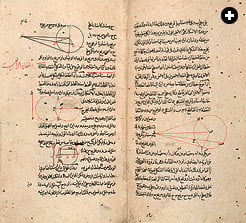 |
| EDINBURGH UNIVERSITY LIBRARY / UNIVERSITY OF EDINBURGH / BRIDGEMAN ART LIBRARY |
| This translation of Euclid’s Elements of Geometry is by the Persian scholar Nasir al-Din al-Tusi. The work is
among the earliest Greek treatises on mathematics. |
Using the geometry of Euclid and Apollonius as starting
points,
Muslim mathematicians went much farther than their Greek predecessors.
While al-Biruni promulgated the first book on trigonometry in the
10th century, it was not until the 13th century that the Maragha
astronomer al-Tusi developed trigonometry into a separate discipline.
After absorbing Apollonius’ book on conic sections such as circles,
parabolas, ellipses and hyperbolas, and deliberating over what was
contained in the lost eighth chapter, Alhazen, the inventor of the
camera obscura, proposed his own version of the book’s ending, adding
solutions for computing the volume of a three-dimensional parabolic
shape.
In 10th-century Baghdad, the mathematician-astronomer Abu Sahl
al-Quhi formulated a life-saving use of trigonometry by employing it to
determine the height and position of lighthouses and to gauge distances
of ships at sea from hidden shoals. The resourceful
scholar also invented the so-called “perfect compass,” a hand-held
mechanical tool with an adjustable arm pivoting around a fixed arm, to trace ellipses and other conic sections.
Enlarging on Indian notions of the sine (the ratio of the
length of the side of a right triangle opposite an acute angle to the length of the hypotenuse), the ninth-century mathematician Habash al-Hasin developed
the concept of tangents (straight lines and planes touching arcs, circles and conic
sections) to facilitate geometrical calculations.
When the multi-talented 11th-century Persian poet Omar Khayyam
was
not rhapsodizing in The Rubaiyat and other verse, he kept busy revising
solar calendars for the Seljuk sultan Jalal al-Din and drafting
geometrical proofs for cubic equations by intersecting parabolas with
circles. The mathematical bard also circulated a visionary critique of Euclid’s theories on parallel lines that prefigured
non-Euclidean geometry, to come some 800 years later.
In several other areas, Arab mathematicians were centuries
ahead of
European theorists. The 13th-century scholar Ibn Munim from Marrakech
used Khayyam’s earlier studies to plot a triangular numerical
grid that allowed him to figure permutations and combinations. This
exercise yields, for example, the maximum number of words that can be
created with the 28 letters of the Arabic alphabet. Four hundred years later, the 17th-century
French mathematician Blaise Pascal reinvented Ibn Munim’s numerical
grid.
The famous last theorem by Pascal’s colleague, Pierre de
Fermat,
offers another example of Muslim scholars presaging European
discoveries. Some 600 years before Fermat posited his mathematical
riddle—that there are no non-zero integers x, y and z such that
xn + yn = zn where n is an integer greater than 2—Muslim scientists
Alhazen, al-Sizji, al-Khazin and others were grappling with a similar
conundrum. Fermat’s enigma would remain unsolved until 1994, when
British mathematician Andrew Wiles at last provided a definitive proof.
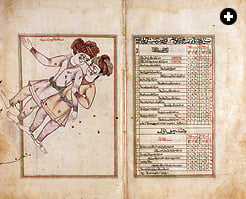 |
| NEW YORK PUBLIC LIBRARY / ART RESOURCE |
| Tenth-century astronomer Abd al-Rahman al-Sufi’s Treatise on
the
Fixed Stars included both pictures and written descriptions of star
patterns, including the Celestial Twins of the constellation Gemini. |
While Islamic mathematicians outstripped their Greek and Indian
predecessors, Muslim doctors used Hippocrates and Galen as springboards
for their own expanded findings about medicine and anatomy. In his seminal Canon, Ibn Sina expanded on Hippocrates’ influential fifth-century
BC work, Airs, Waters, Places, by enumerating the effects that clean
air and water and salubrious mountain and coastal environments have on
health. Some Arab critiques of Greek physicians were pointedly
specific. Writing about a famine in Egypt around 1200, Abd al-Latif
al-Baghdadi recounts his observations of the skeletons of starvation
victims, noting that the lower jaw consisted of a single bone, instead
of two articulated bones, as Galen had wrongly concluded. Neither Galen
nor al-Baghdadi was able to dissect human bodies, due to religious
taboos that lasted until the 17th century.
Even before the consolidation of the Islamic empire, the Arabs
sought to raise the abysmal standards of public health, with the first
Muslim hospital opening in Damascus in 706. “One of the great successes
of Arabic medicine was the organization of hospitals at a level that
far surpassed Greek, Roman or Persian models,” says Djebbar.
Beginning in the late eighth century when Caliph Harun
al-Rashid
established a Baghdad hospital, doctors made daily rounds with their
students, setting a precedent used in medical schools ever since.
Typically, there was one courtyard wing for physically ill patients,
another for those with moderate mental health problems and a third for
those suffering from more severe psychological disorders. “In addition
to music therapy, the courtyards all had fountains, trees and
warbling birds so that the sounds of nature were part of the healing
process,” notes the Lille professor.
A handful of institutions boasted incredibly luxurious
circumstances. According to Ahmed Issa Bey in his 1928 book The History
of Hospitals in Islam, the 12th-century Almohad ruler Abu Yusuf Ya’qub
al-Mansur provided the fortunate patients of his Marrakech facility
with running water in every room, wool blankets, silk sheets, free
medicines and 30 dinars a day for food and other necessities. When
indigent patients got well enough to leave, they received a small sum
of money to ease their reentry into working society.
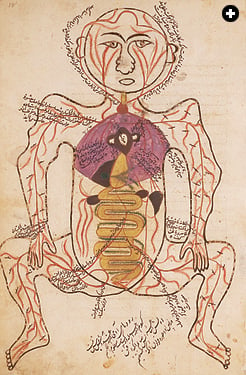 |
| NATIONAL LIBRARY OF MEDICINE |
| Mansur ibn Ilyas’s 14th-century work on anatomy contained
illustrated chapters on five systems of the body: bones, nerves,
muscles, veins and arteries. This page depicts the arteries, with the
internal organs shown in watercolors. |
A few of these medieval hospital buildings still exist intact,
even
though they now serve different purposes. Aleppo’s 14th-century Argun
Maristan is a dramatic backdrop for folk dance, and a 12th-century
stone hospital in Damascus houses the National Museum of Arabic Medicine and Science. Cairo’s Qalawun
hospital, which treated some 4000 patients a day when it was constructed in the 13th century and accommodated lecture halls,
a mosque and doctors’ residences, is currently one of the top
ophthalmology clinics in Egypt.
Although physicians had to be certified, scores of uncertified
barbers and itinerant surgeons practiced bloodletting, tooth extraction
and more dangerous operations with few anesthetics or antiseptics.
Surgery was so chancy in the 10th century that even the adventurous
doctor Rhazes refused to allow ophthalmologists to remove his
cataracts. But by the 14th century, the situation had improved
dramatically. Persian surgeon Mansur ibn Ilyas produced sophisticated
anatomical drawings tracing nerves, veins, arteries, muscles and
complex organs like the heart and brain that aided him immensely in
conducting effective operations.
Al-Zahrawi and other healers sang the praises of herbal cures,
recommending the duhn, or oil, of laurel, wheat, sweet and bitter
almonds, mustard and other plants. Wild mint purportedly relieved
fatigue when used as a compress and drove out colds if taken as
nose drops. “It will also cure the sting of a scorpion,” the
10th-century Córdoban doctor promised patients. One look at
the
fearsome arsenal of surgical tools in al-Zahrawi’s Al-Tasrif made quick
converts to less intrusive herbal nostrums.
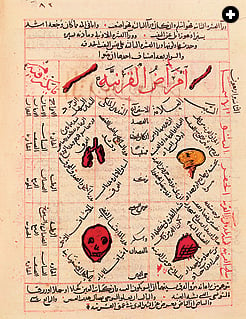 |
| NATIONAL MUSEUM, DAMASCUS / BRIDGEMAN ART LIBRARY |
| This page from a 14th-century copy of Avicenna’s five-volume Canon of Medicine describes several internal
organs, as well as the skull and bones. The Canon was a compilation of
Greek and Islamic medical knowledge. |
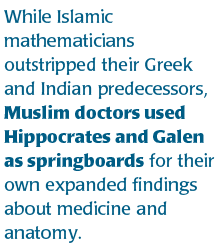
Chemistry, a word derived from the Arabic al-kimya, was vigorously promoted, fostering a rigorous
routine of trial-and-error experimentation that did not become widespread in Europe until the 18th century with
Joseph Priestley, Antoine Lavoisier and other empirical researchers. According to the 10th-century
bibliographer Ibn al-Nadim, Arab chemists manufactured waterproof
fabrics, invisible inks and mosquito repellents. Around the same time,
the Fatimid caliph al-Mu’izz designed a primitive pen with a
self-contained ink cartridge nearly nine centuries before the Romanian student Petrache Poenaru invented the fountain pen in Paris in 1827.
The distillation of rosewater and other perfumes evolved into
a
Muslim specialty, with scents used medicinally to treat migraines,
epilepsy and melancholy. In Kitab kimya al-’utoor w’ al-tas’idat
(Book of the Chemistry of Perfumes and Distillations), the
ninth-century scientist Abu Yusuf al-Kindi lists formulas for preparing
some 107 perfumes.
In his survey of optics, the 10th-century Baghdad scholar Ibn
Sahl
observed that light passing through crystals, water and other
translucent substances slows down and is bent at different angles
according to the density of the material—the basic principle of
refraction. According to Rashed, this was reformulated in the 17th
century by Dutch scholar Willebrord van Roijen Snell and French
mathematician René Descartes as the Snell-Descartes law, or
the law of
sines. In the early 14th century, more than 300 years after Ibn
Sahl, Maragha astronomer-mathematician Kamal al-Din al-Farisi
experimented with a glass sphere filled with water to analyze the way
sunlight breaks into the spectrum colors of a rainbow.
The 12th-century Persian physicist Abdur Rahman al-Hazini
incorporated Archimedes’ findings on the density, buoyancy and specific
gravity of objects to perfect “the balance of wisdom,” an ingenious
scale that resembled a miniature Calder mobile. Originally invented by
Abu Hatim al-Isfizari, the device consisted of five hanging trays, one
of which was immersed in water to verify precise amounts of gold,
silver and other precious metals in coins, jewelry and other materials.
Even as gold and silver mining expanded, the fabrication of
artificial rubies, sapphires and other gems grew into a lucrative
industry. Poring over the works of Egyptian and Greek alchemists, a
handful of Muslim scientists employed their expertise in minerals to
dabble in the elusive quest for an elixir, a magical “philosopher’s
stone,” capable of transforming lead to gold. All failed, of course.
The eighth-century Persian scientist Jabir ibn Hayyan (Geber in the
West), however, turned these experimental dead ends to advantage,
concocting an array of previously unknown compounds, including sulfuric
acid, caustic soda and nitric oxide, Djebbar explains.
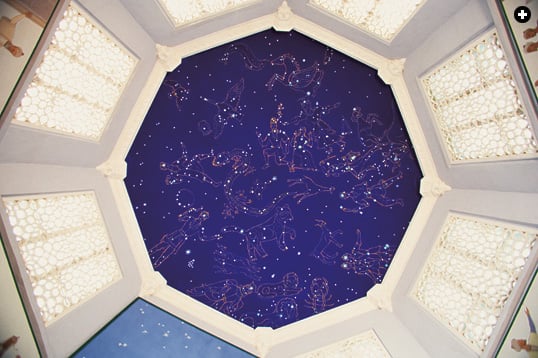 |
| JANET WISHNETSKY / CORBIS |
| A painting of constellations adorns the ceiling of the
famous
Ulugh Beg Observatory in Samarkand, Uzbekistan, which takes its name
from its founder, the grandson of Tamerlane, who inaugurated it in
1420. |
Far more useful than the alchemists’ hunt for gold were
al-Biruni’s
pioneering treatises on mineralogy and geology. In one work, the
Persian scholar, who spent much of his career in Ghazni in Afghanistan, asserted that the desert was once covered by
the sea. He supported this controversial thesis with detailed descriptions of perfectly preserved fossils
of fish and other aquatic creatures, paving the way for paleontology.

Despite centuries of innovation, Islamic science ultimately
went into an irreversible decline with the eclipse of Arab political and economic
power, marked in the West by the fall of Granada in 1492 to the
Castilian monarchs Ferdinand and Isabella, and in the East by the muscular expansion of the Ottoman Empire in the 16th century under Süleyman the Magnificent. But this slide into
decadence was a slow process.
Surprisingly, perhaps, the Crusades in the 12th and 13th
centuries
did more to energize Muslim science than retard it, according to
Rashed. (See “Lines of Transmission”). “The Crusades
encouraged Muslims & to find out the secrets of their enemies’ forces,” he contends.
The first crippling blow to Islamic science occurred with the
Mongol
invasions, culminating in the devastating sack of Baghdad in 1258, when
two million Muslims were massacred, libraries, laboratories, hospitals
and the landmark House of Wisdom were destroyed, and the Tigris
ran red with the blood of scholars and black with the ink of their
books. “Even after the Mongol invasions, there was still a substantial
amount of scientific investigation,” Rashed observes, “but scholars had
to spend more time and energy preserving knowledge instead of pushing
ahead with new explorations.”
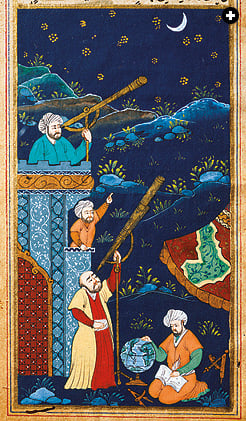 |
| ART ARCHIVE / UNIVERSITY
LIBRARY, istanbul |
| Astronomers study the moon and the stars in this Ottoman
miniature dating from the 17th century. |
Another long-term reversal began in the 15th century, as
Portuguese and Spanish navigators in heavily armed vessels exploited
sea-trade routes between East and West. The slow-moving caravans of the
Silk Road were gradually abandoned, breaking the Arab monopoly on
commerce with the Orient and further undermining scientific progress,
according to Rashed.
“Arabic science had arrived at a critical turning point where
a
cognitive revolution was needed in order to continue,” the French
science historian explains. In mathematics, for example, complex
equations became so cumbersome they required 50 pages to articulate.
“Creating new symbols to condense these equations required a conceptual
leap that’s possible in a society in expansion, but not in a society in decline,” says Rashed.
With the rise of Ottoman hegemony, the heyday of Islamic
science drew to a close, he argues, since Turkish rulers were far more interested in
pursuing military goals and piling up layers of bureaucracy than in
encouraging research.
But the lessons of Islamic science have yet to be fully
appreciated,
even in the Arab world, Audouze maintains, where the unprecedented
accomplishments of generations of medieval scholars should inspire contemporary Muslims to rebuild the foundations for a new round of discoveries.
“Science only develops in cultivated societies where the
economy and
commerce are in good health,” says the French astrophysicist. “And it
creates a virtuous circle where the economy favors science which
in turn generates profits and wealth of all kinds, spiritual as well as
material.”
 |
Paris-based author Richard Covington writes about culture, history and science for Smithsonian, The International
Herald Tribune, U.S. News & World Report and the London Sunday Times. His e-mail is richardpeacecovington@gmail.com. |